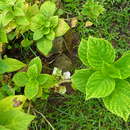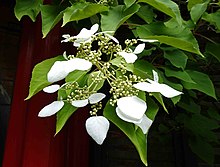en
names in breadcrumbs



Hydrangeaceae is a family of flowering plants in the order Cornales, with a wide distribution in Asia and North America, and locally in southeastern Europe.[3]
The genera are characterised by leaves in opposite pairs (rarely whorled or alternate), and regular, bisexual flowers with 4 (rarely 5–12) petals. The fruit is a capsule or berry containing several seeds, the seeds with a fleshy endosperm.
The following genera are accepted:[4]
The family Hydrangeaceae has two subfamilies, namely Jamesioideae and Hydrangeoideae. The subfamily Jamesioideae comprises the genera Jamesia and Fendlera.[5][6] They are the sister group to the remaining Hydrangeaceae.[6][7] The subfamily Hydrangeoideae has two tribes:[8][6][7] Hydrangeae consists of Hydrangea s.l.,[8] and Philadelpheae consists of Philadelphus, Carpenteria, Deutzia, Kirengeshoma, Whipplea, and Fendlerella.[6][7] Carpenteria is the sister group to Philadelphus. Deutzia is the sister group to Kirengeshoma, and Fendlerella is the sister group to Whipplea.[7][5][6] However the relationships among those three clades within the tribe Philadelphae are a bit unclear.[7] The following cladogram summarizes results from different studies, and for each node it is noted which studies support the sister group positions of the following branches:
Hydrangeaceae[6][7] Hydrangeoideae[6][7] Hydrangeae[6]Hydrangea s.l. (including Broussaisia, Cardiandra, Decumaria, Deinanthe, Dichroa, Pileostegia, Platycrater, and Schizophragma)[8]
Philadelpheae[6] [6][5][8][7]Philadelphus
Carpenteria
[6] [5][6][7]Deutzia
Kirengeshoma
[5][6][7]Whipplea
Fendlerella
Jamesioideae[6][5][7]Jamesia
Fendlera
 Hydrangea hydrangeoides, a member of the now-synonymised genus Schizophragma
Hydrangea hydrangeoides, a member of the now-synonymised genus Schizophragma Hydrangeaceae is a family of flowering plants in the order Cornales, with a wide distribution in Asia and North America, and locally in southeastern Europe.